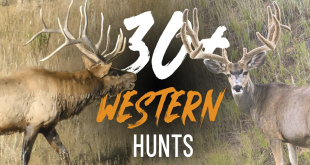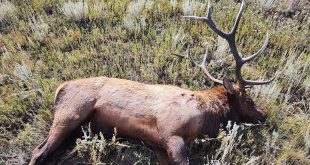Arizona has a big game draw process whose complexity rivals the trophy quality of its elk tags. If you are familiar with how the AZ system works, read on, for those who are new to applying in AZ or who haven’t read up on it in a while, scroll to the bottom for some basic information on how it all works.
The Basics
- Applications are due by 11:59 on February 14, 2023
- Applications must be submitted online @ https://draw.azgfd.com/
- All applicants must have a hunting license valid through the draw application deadline.
- Arizona requires all applicants to enter credit card information at the time of application, but only the application fee is paid at that time. The remaining cost is only charged to the card if a tag is drawn.
- Application fees are $13 for residents and $15 for non-residents.
- Bonus points can be purchased for the same cost as an application fee and are only available during the draw application period.
- For a full breakdown of the draw process visit the AZGFD website: https://www.azgfd.com/hunting/draw/process/
Strategies
For those of you with your heart set on hunting blue chip units in the rut I will keep this very simple. There are a handful of units in AZ that consistently produce top end bulls; 1, 3C, 9, 10, 23(North and South) and 27. All of these are exceptional elk units with high densities and solid age class. Hunting any of these units in September is truly the experience of a lifetime and it will likely take a lifetime to draw one. Archery hunts in any of these units will require double digit bonus points and a firearm hunt will require somewhere in the upper 20’s to draw.
2023 Hunt Dates
Arizona Game and Fish uses a hunt scheduling process by which almost all big game hunts start on a designated Friday of the year. This means that hunt dates can vary by about a week depending on when the first Friday occurs. That translates into what can be a significant shift in dates every sixth year when the first Friday is late in the first week of January.
Early Archery Hunts – These are the most popular and prized hunts in the state. For 2023 the hunts start on September 15 on a new moon. These are likely to be peak rut with lots of action. I had a similar hunt in 2017 and we had phenomenal rut action throughout the entire hunt. The only drawback is that you will be racing against the moon as it gets bigger and brighter each night, giving pressured elk more opportunity to keep the party going after sunset.
Early Firearms Hunts – The dates of the firearm hunts are pretty good from a rut standpoint, with most beginning on September 29. The rut should be in full swing at this point and with a limited number of tags for these hunts, the bulls shouldn’t be getting a lot of attention after archery. The big BUT on these is that the hunt starts on a full moon. Those big, bright moons, in open country can leave a lot of light for rutting elk. These dates make me a little nervous.
Late Rifle Hunts – Typically the start of these hunts aligns with the Friday after Thanksgiving. Due to the calendar in 2023 the hunts will start on December 1. I know a lot of locals like the holiday start for these hunts to help save on PTO, so there may be some reluctance by a few because of that. I don’t think that impact will be measurable in the draw data, but is a consideration for some. More importantly, these dates increase the possibility of cold weather or snowfall. In Arizona, snowy weather is a two-edged sword. Every elk hunter knows that a fresh blanket of the white stuff helps with locating elk and driving them out of the high mountain peaks. One thing to consider is that this far South we don’t have the same resources as other Rocky Mountain states. This can mean road closures which can be extremely aggravating. It is also very likely that after a big storm, the weather will return to its normal sunny identity and create a lot of mud. This can all be navigated, and some REALLY big bulls have come during snowy Grand Canyon weather. As far as the moon phase, this one is average and during a cold late hunt I generally don’t worry as much about that as I do on early hunts.
Fewer than 10 Bonus Points
If you are set on hunting early, I recommend taking advantage of Arizona’s two choice system and picking out your dream blue chip hunt and putting it as your first choice. On your second choice, find a green chip archery hunt with more favorable draw odds.
If you are considering late rifle or archery hunts, there are a few that can be drawn with 5-6 points for residents and 9-10 for non-residents. Be sure that if you are applying for one of these that you are not putting a harder to draw hunt first, or else it won’t be considered because you will draw your second choice in the bonus point pass before the random draw pass occurs.
10-20 Bonus Points
When the stars align and Arizona has an excellent monsoon, followed by above average winter moisture AND the archery elk hunt starts on September 15 . . . I am going to do everything in my power to get my hands on a tag. I believe that the archery hunts will produce more big bulls than the rifle hunts this year. There are a few blue chip late rifle hunts that are also worth the point burn. If you aren’t an archer, these will be solid hunts and trophy quality should be solid.
20+ Bonus Points
In this range, most hunters are focused on rifle or muzzleloader hunts. Hunting elk in late September in AZ is a pretty exciting proposition, but this year, if I am a very high point holder, I am sitting out. Instead I would opt for archery hunts in units 23, 9 or 10. With an extra week to hunt, peak rut activity, good moon phase, and above average moisture I think the archery hunts are going to be prime. If archery is not an option, Unit 5A has an early rifle hunt that starts mid-September but don’t expect the trophy quality you would get in blue chip units.
Rules of Thumb
- The system is a hybrid preference/bonus point process.
- Choices 1 and 2 are most important. Almost no bull tags can be drawn as a 3rd choice.
- Arizona gives the first 20% of the tags to the applicants with the highest point total. If you are among the highest point holders for your second choice hunt, you will draw that hunt before your first choice is considered in the random draw.
- There is a 10% non-resident cap on all antlered elk hunts. Only half of these can be issued via the maximum point pass. The other half may only be issued via the random pass.
- Arizona has several “Limited Opportunity” hunts. These are typically in small sub-units with low elk densities. If the draw odds look too good to be true, they probably are.
- Although AZ offers OTC elk permits, they are only valid in very limited areas with extremely low densities. These hunts are tailored for locals with real time knowledge of elk whereabouts. I do not recommend these hunts for non-residents.
 Eastmans' Official Blog | Mule Deer, Antelope, Elk Hunting and Bowhunting Magazine | Eastmans' Hunting Journals
Eastmans' Official Blog | Mule Deer, Antelope, Elk Hunting and Bowhunting Magazine | Eastmans' Hunting Journals





